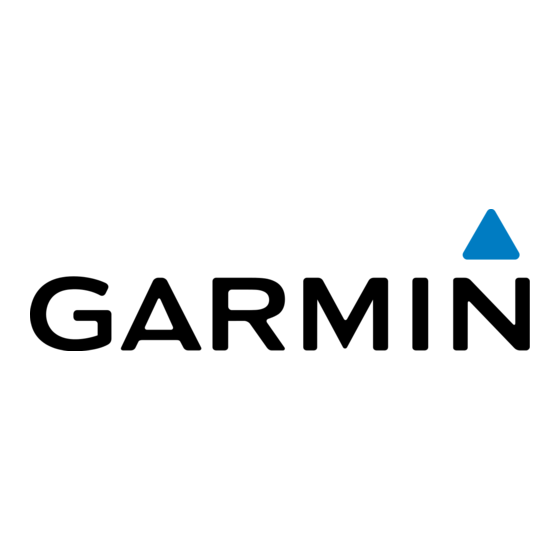Garmin echoMAP CHIRP 90 series Manuale d'uso - Pagina 7
Sfoglia online o scarica il pdf Manuale d'uso per Sistema GPS marino Garmin echoMAP CHIRP 90 series. Garmin echoMAP CHIRP 90 series 34. Fishfinder-chartplotter combo
Anche per Garmin echoMAP CHIRP 90 series: Manuale di istruzioni per l'installazione (6 pagine)

TIP: To reset the pin and measure from the current location of
the cursor, select SELECT.
Chart Symbols
This table contains some of the common symbols you might see
on the detailed charts.
Icon
Description
Buoy
Information
Marine services
Tide station
Current station
Overhead photo available
Perspective photo available
Other features common to most charts include depth contour
lines, intertidal zones, spot soundings (as depicted on the
original paper chart), navigational aids and symbols,
obstructions, and cable areas.
Navigating to a Point on the Chart
The Auto Guidance feature is based on electronic chart
information. That data does not ensure obstacle and bottom
clearance. Carefully compare the course to all visual sightings,
and avoid any land, shallow water, or other obstacles that may
be in your path.
When using Go To, a direct course and a corrected course may
pass over land or shallow water. Use visual sightings, and steer
to avoid land, shallow water, and other dangerous objects.
NOTE: The offshore Fishing chart is available with premium
charts, in some areas.
NOTE: Auto Guidance is available with premium charts, in some
areas.
1
From the Navigation chart or Fishing chart, select a location.
2
If necessary, select SELECT.
3
Select Navigate To.
4
Select an option:
• To navigate directly to the location, select Go To.
• To create a route to the location, including turns, select
Route To.
• To use Auto Guidance, select Guide To.
5
Review the course indicated by the magenta line.
NOTE: When using Auto Guidance, a gray segment within
any part of the magenta line indicates that Auto Guidance
cannot calculate part of the Auto Guidance line. This is due to
the settings for minimum safe water depth and minimum safe
obstacle height.
6
Follow the magenta line, steering to avoid land, shallow
water, and other obstacles.
Viewing Location and Object Information on a Chart
You can view information about a location or an object on the
Navigation chart or the Fishing chart.
NOTE: The offshore Fishing chart is available with premium
charts, in some areas.
1
From the Navigation chart or Fishing chart, select a location
or object.
A list of options appears along the right side of the chart. The
options that appear vary based on the location or object you
selected.
Charts and 3D Chart Views
CAUTION
2
Select an option:
• To navigate to the selected location, select Navigate To.
• To mark a waypoint at the cursor location, select New
Waypoint.
• To view the distance and bearing of the object from your
current location, select Measure Distance.
The distance and bearing appear on the screen. Select
SELECT to measure from a location other than your
current location.
• To view tide, current, celestial, chart notes, or local
services information near the cursor, select Information.
Viewing Details about Navaids
From the Navigation chart, Fishing chart, Perspective 3D chart
view, or Mariner's Eye 3D chart view, you can view details about
various types of navigation aids, including beacons, lights, and
obstructions.
NOTE: The offshore Fishing chart is available with premium
charts, in some areas.
NOTE: Mariner's Eye 3D and Fish Eye 3D chart views are
available with premium charts, in some areas.
1
From a chart or 3D chart view, select a navaid.
2
Select the name of the navaid.
Heading Line and Angle Markers
The heading line is an extension drawn on the map from the
bow of the boat in the direction of travel. Angle markers indicate
where you should navigate and are helpful for casting.
Setting the Heading and Course Over Ground Lines
You can show the heading line and the course over ground
(COG) line on the chart.
COG is your direction of movement. Heading is the direction the
bow of the boat is pointed, when a heading sensor is connected.
1
From a chart view, select MENU > Chart Setup > Chart
Appearance > Heading Line.
2
If necessary, select Source, and select an option:
• To automatically use the source available, select Auto.
• To use the GPS antenna heading for COG, select GPS
Heading (COG).
• To use data from a connected heading sensor, select
Heading.
• To use data from both a connected heading sensor and
the GPS antenna, select COG and Heading.
This displays both the heading line and the COG line on
the chart.
3
Select Display, and select an option:
• Select Distance > Distance, and enter the length of the
line shown on the chart.
• Select Time > Time, and enter the time used to calculate
the distance your boat will travel in the specified time at
your present speed.
Turning on Angle Markers
You can add angle markers to the map along the heading line.
Angle markers can be helpful for casting when fishing.
1
Set the heading line
(Setting the Heading and Course Over
Ground Lines, page
3).
2
Select Angle Markers.
Premium Charts
The Auto Guidance feature is based on electronic chart
information. That data does not ensure obstacle and bottom
clearance. Carefully compare the course to all visual sightings,
CAUTION
3
